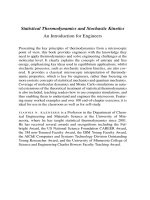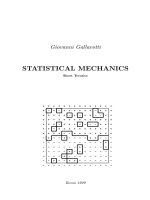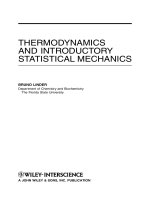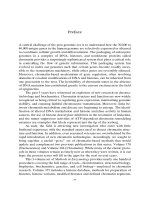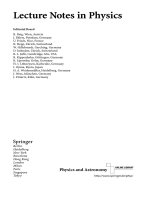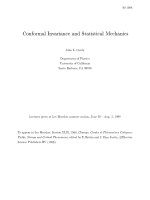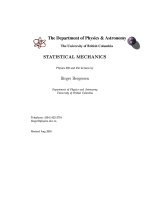- Trang chủ >>
- Khoa Học Tự Nhiên >>
- Vật lý
thermodynamics and introductory statistical mechanics - linder b.
Bạn đang xem bản rút gọn của tài liệu. Xem và tải ngay bản đầy đủ của tài liệu tại đây (836.33 KB, 219 trang )
THERMODYNAMICS
AND INTRODUCTORY
STATISTICAL MECHANICS
BRUNO LINDER
Department of Chemistry and Biochemistry
The Florida State University
A JOHN WILEY & SONS, INC. PUBLICATION
Copyright # 2004 by John Wiley & Sons, Inc. All rights reserved.
Published by John Wiley & Sons, Inc., Hoboken, New Jersey.
Published simultaneously in Canada.
No part of this publication may be reproduced, stored in a retrieval system, or transmitted in any
form or by any means, electronic, mechanical, photocopying, recording, scanning, or otherwise,
except as permitted under Section 107 or 108 of the 1976 United States Copyright Act, without either the
prior written permission of the Publisher, or authorization through payment of the appropriate per-copy
fee to the Copyright Clearance Center, Inc., 222 Rosewood Drive, Danvers, MA 01923, 978-750-8400,
fax 978-646-8600, or on the web at www.copyright.com. Requests to the Publisher for permission should
be addressed to the Permissions Department, John Wiley & Sons, Inc., 111 River Street, Hoboken,
NJ 07030, (201) 748-6011, fax (201) 748-6008.
Limit of Liability/Disclaimer of Warranty: While the publisher and author have used their best efforts in
preparing this book, they make no representations or warranties with respect to the accuracy or
completeness of the contents of this book and specifically disclaim any implied warranties of
merchantability or fitness for a particular purpose. No warranty may be created or extended by sales
representatives or written sales materials. The advice and strategies contained herein may not be suitable
for your situation. You should consult with a professional where appropriate. Neither the publisher nor
author shall be liable for any loss of profit or any other commercial damages, including but not limited to
special, incidental, consequential, or other damages.
For general information on our other products and services please contact our Customer Care Department
within the U.S. at 877-762-2974, outside the U.S. at 317-572-3993 or fax 317-572-4002.
Wiley also publishes its books in a variety of electronic formats. Some content that appears in print,
however, may not be available in electronic format.
Library of Congress Cataloging-in-Publication Data:
Linder, Bruno.
Thermodynamics and introductory statistical mechanics/Bruno Linder.
p. cm.
Includes bibliographical references and index.
ISBN 0-471-47459-2
1. Thermodynamics. 2. Statistical mechanics. I Title.
QD504.L56 2005
541
0
.369–dc22 2004003022
Printed in the United States of America
10987654321
To Cecelia
and to William, Diane, Richard, Nancy, and Carolyn
CONTENTS
PREFACE xv
1 INTRODUCTORY REMARKS 1
1.1 Scope and Objectives / 1
1.2 Level of Course / 2
1.3 Course Outline / 2
1.4 Books / 3
PART I THERMODYNAMICS 5
2 BASIC CONCEPTS AND DEFINITIONS 7
2.1 Systems and Surroundings / 8
2.2 State Variables and Thermodynamic Properties / 8
2.3 Intensive and Extensive Variables / 9
2.4 Homogeneous and Heterogeneous Systems, Phases / 9
2.5 Work / 9
2.6 Reversible and Quasi-Static Processes / 10
2.6.1 Quasi-Static Process / 11
2.6.2 Reversible Process / 12
2.7 Adiabatic and Diathermal Walls / 13
2.8 Thermal Contact and Thermal Equilibrium / 13
vii
3 THE LAWS OF THERMODYNAMICS I 14
3.1 The Zeroth Law—Temperature / 15
3.2 The First Law—Traditional Approach / 16
3.3 Mathematical Interlude I: Exact and Inexact Differentials / 18
3.4 The First Law—Axiomatic Approach / 19
3.5 Some Applications of the First Law / 23
3.5.1 Heat Capacity / 23
3.5.2 Heat and Internal Energy / 23
3.5.3 Heat and Enthalpy / 24
3.6 Mathematical Interlude II: Partial Derivatives / 26
3.6.1 Relations Between Partials of Dependent Variables / 26
3.6.2 Relations Between Partials with
Different Subscripts / 27
3.7 Other Applications of the First Law / 27
3.7.1 C
P
À C
V
/27
3.7.2 Isothermal Change, Ideal Gas / 28
3.7.3 Adiabatic Change, Ideal Gas / 28
3.7.4 The Joule and the Joule-Thomson Coefficients / 29
4 THE LAWS OF THERMODYNAMICS II 32
4.1 The Second Law—Traditional Approach / 32
4.2 Engine Efficiency: Absolute Temperature / 36
4.2.1 Ideal Gas / 36
4.2.2 Coupled Cycles / 36
4.3 Generalization: Arbitrary Cycle / 38
4.4 The Clausius Inequality / 39
4.5 The Second Law—Axiomatic Approach (Carathe
´
odory) / 41
4.6 Mathematical Interlude III: Pfaffian Differential Forms / 43
4.7 Pfaffian Expressions in Two Variables / 44
4.8 Pfaffian Expressions in More Than Two Dimensions / 44
4.9 Carathe
´
odory’s Theorem / 45
4.10 Entropy—Axiomatic Approach / 45
4.11 Entropy Changes for Nonisolated Systems / 48
4.12 Summary / 49
4.13 Some Applications of the Second Law / 50
4.13.1 Reversible Processes (PV Work Only) / 50
4.13.2 Irreversible Processes / 51
viii CONTENTS
5 USEFUL FUNCTIONS: THE FREE ENERGY
FUNCTIONS 52
5.1 Mathematical Interlude IV: Legendre Transformations / 53
5.1.1 Application of the Legendre Transformation / 54
5.2 Maxwell Relations / 55
5.3 The Gibbs-Helmholtz Equations / 55
5.4 Relation of ÁA and ÁG to Work: Criteria for Spontaneity / 56
5.4.1 Expansion and Other Types of Work / 56
5.4.2 Comments / 57
5.5 Generalization to Open Systems and Systems of
Variable Composition / 58
5.5.1 Single Component System / 58
5.5.2 Multicomponent Systems / 59
5.6 The Chemical Potential / 59
5.7 Mathematical Interlude V: Euler’s Theorem / 60
5.8 Thermodynamic Potentials / 61
6 THE THIRD LAW OF THERMODYNAMICS 65
6.1 Statements of the Third Law / 66
6.2 Additional Comments and Conclusions / 68
7 GENERAL CONDITIONS FOR EQUILIBRIUM
AND STABILITY 70
7.1 Virtual Variations / 71
7.2 Thermodynamic Potentials—Inequalities / 73
7.3 Equilibrium Condition From Energy / 75
7.3.1 Boundary Fully Heat Conducting, Deformable,
Permeable (Normal System) / 75
7.3.2 Special Cases: Boundary Semi-Heat Conducting,
Semi-Deformable, or Semi-Permeable / 76
7.4 Equilibrium Conditions From Other Potentials / 77
7.5 General Conditions for Stability / 78
7.6 Stability Conditions From E / 78
7.7 Stability Conditions From Cross Terms / 80
7.8 Stability Conditions From Other Potentials / 81
7.9 Derivatives of Thermodynamic Potentials With Respect
to Intensive Variables / 82
CONTENTS ix
8 APPLICATION OF THERMODYNAMICS
TO GASES, LIQUIDS, AND SOLIDS 83
8.1 Gases / 83
8.2 Enthalpy, Entropy, Chemical Potential, Fugacity / 85
8.2.1 Enthalpy / 85
8.2.2 Entropy / 86
8.2.3 Chemical Potential / 87
8.2.4 Fugacity / 88
8.3 Standard States of Gases / 89
8.4 Mixtures of Gases / 90
8.4.1 Partial Fugacity / 90
8.4.2 Free Energy, Entropy, Enthalpy, and Volume
of Mixing of Gases / 90
8.5 Thermodynamics of Condensed Systems / 91
8.5.1 The Chemical Potential / 92
8.5.2 Entropy / 93
8.5.3 Enthalpy / 93
9 PHASE AND CHEMICAL EQUILIBRIA 94
9.1 The Phase Rule / 94
9.2 The Clapeyron Equation / 96
9.3 The Clausius-Clapeyron Equation / 97
9.4 The Generalized Clapeyron Equation / 98
9.5 Chemical Equilibrium / 99
9.6 The Equilibrium Constant / 100
10 SOLUTIONS—NONELECTROLYTES 102
10.1 Activities and Standard State Conventions / 102
10.1.1 Gases / 102
10.1.2 Pure Liquids and Solids / 103
10.1.3 Mixtures / 103
10.1.3.1 Liquid–Liquid Solutions—Convention I
(Con I) / 104
10.1.3.2 Solid–Liquid Solutions—Convention II
(Con II) / 104
10.2 Ideal and Ideally Dilute Solutions; Raoult’s and
Henry’s Laws / 104
x CONTENTS
10.2.1 Ideal Solutions / 104
10.2.2 Ideally Dilute Solutions / 105
10.3 Thermodynamic Functions of Mixing / 107
10.3.1 For Ideal Solutions / 107
10.3.2 For Nonideal Solutions / 107
10.4 Colligative Properties / 108
10.4.1 Lowering of Solvent Vapor Pressure / 108
10.4.2 Freezing Point Depression / 109
10.4.3 Boiling Point Elevation / 111
10.4.4 Osmotic Pressure / 112
11 PROCESSES INVOLVING WORK OTHER THAN
PRESSURE-VOLUME WORK 114
11.1 P-V Work and One Other Type of Work / 115
11.2 P-V, sA, and fL Work / 116
12 PHASE TRANSITIONS AND CRITICAL
PHENOMENA 119
12.1 Stable, Metastable, and Unstable Isotherms / 120
12.2 The Critical Region / 124
PART II INTRODUCTORY STATISTICAL
MECHANICS 127
13 PRINCIPLES OF STATISTICAL MECHANICS 129
13.1 Introduction / 129
13.2 Preliminary Discussion—Simple Problem / 130
13.3 Time and Ensemble Averages / 131
13.4 Number of Microstates,
D
, Distributions D
i
/ 132
13.5 Mathematical Interlude VI: Combinatory Analysis / 134
13.6 Fundamental Problem in Statistical Mechanics / 136
13.7 Maxwell-Boltzmann, Fermi-Dirac, Bose-Einstein Statistics.
‘‘Corrected’’ Maxwell-Boltzmann Statistics / 137
13.7.1 Maxwell-Boltzmann Statistics / 137
13.7.2 Fermi-Dirac Statistics / 137
13.7.3 Bose-Einstein Statistics / 137
13.7.4 ‘‘Corrected’’ Maxwell-Boltzmann Statistics / 138
13.8 Systems of Distinguishable (Localized) and Indistinguishable
(Nonlocalized) Particles / 139
CONTENTS xi
13.9 Maximizing
D
/ 139
13.10 Probability of a Quantum State: The Partition Function / 140
13.10.1 Maxwell-Boltzmann Statistics / 140
13.10.2 Corrected Maxwell-Boltzmann Statistics / 141
14 THERMODYNAMIC CONNECTION 143
14.1 Energy, Heat, and Work / 143
14.2 Entropy / 144
14.2.1 Entropy of Nonlocalized Systems (Gases) / 145
14.2.2 Entropy of Localized Systems
(Crystalline Solids) / 145
14.3 Identification of b with 1/kT / 145
14.4 Pressure / 146
14.5 The Functions E, H, S, A, G, and m / 147
15 MOLECULAR PARTITION FUNCTION 150
15.1 Translational Partition Function / 151
15.2 Vibrational Partition Function: Diatomics / 152
15.3 Rotational Partition Function: Diatomics / 152
15.4 Electronic Partition Function / 154
15.5 Nuclear Spin States / 154
15.6 The ‘‘Zero’’ of Energy / 155
16 STATISTICAL MECHANICAL APPLICATIONS 158
16.1 Population Ratios / 158
16.2 Thermodynamic Functions of Gases / 159
16.3 Equilibrium Constants / 161
16.4 Systems of Localized Particles: The Einstein Solid / 164
16.4.1 Energy / 164
16.4.2 Heat Capacity / 165
16.4.3 Entropy / 165
16.5 Summary / 166
ANNOTATED BIBLIOGRAPHY 167
APPENDIX I HOMEWORK PROBLEM SETS 169
Problem Set I / 169
Problem Set II / 170
xii CONTENTS
Problem Set III / 171
Problem Set IV / 172
Problem Set V / 173
Problem Set VI / 173
Problem Set VII / 174
Problem Set VIII / 175
Problem Set IX / 175
Problem Set X / 176
APPENDIX II SOLUTIONS TO PROBLEMS 177
Solution to Set I / 177
Solution to Set II / 179
Solution to Set III / 181
Solution to Set IV / 185
Solution to Set V / 187
Solution to Set VI / 189
Solution to Set VII / 191
Solution to Set VIII / 194
Solution to Set IX / 195
Solution to Set X / 198
INDEX 201
CONTENTS xiii
PREFACE
This book is based on a set of lecture notes for a one-semester first-year
chemistry graduate course in Thermodynamics and Introductory Statistical
Mechanics, which I taught at Florida State University in the Fall of 2001 and
2002 and at various times in prior years. Years ago, when the University was
on the quarter system, one quarter was devoted to Thermodynamics, one
quarter to Introductory Statistical Mechanics, and one quarter to Advanced
Statistical Mechanics. In the present semester system, roughly two-thirds of
the first-semester course is devoted to Thermodynamics and one-third to
Introductory Statistical Mechanics. Advanced Statistical Mechanics is
taught in the second semester.
Thermodynamics is concerned with the macroscopic behavior of matter,
or rather with processes on a macroscopic level. Statistical Mechanics
relates and interprets the properties of a macroscopic system in terms of
its microscopic units. In this book, Thermodynamics was developed strictly
from a macroscopic point of view without recourse to Statistical-Mechanical
interpretation, except for some passing references to fluctuations in the dis-
cussion of critical phenomena. Both Thermodynamics and Statistical
Mechanics entail abstract ideas, and, in my opinion, it is best not to intro-
duce them simultaneously. Accordingly, the first 12 chapters (Part I) deal
exclusively with Thermodynamics; Statistical Mechanics is only then intro-
duced.
Thermodynamics, unlike some other advanced subjects in Physical
Chemistry, does not require complicated mathematics, and for this reason
the subject is often thought to be ‘‘easy.’’ But if it is easy, it is deceptively
xv
easy. There are subtleties and conceptual difficulties, often ignored in
elementary treatments, which tend to obscure the logical consistency of
the subject. In this book, conceptual difficulties are not ‘‘swept under the
rug’’ but brought to the fore and discussed critically. Both traditional and
axiomatic approaches are developed, and reasons are given for presenting
alternative points of view. The emphasis is on the logical structure and
generality of the approach, but several chapters on applications are included.
The aim of the book is to achieve a balance between fundamentals and
applications.
In the last four chapters of the book, which are devoted to Statistical
Mechanics, not much more can be hoped to be accomplished than to cover,
from an elementary point of view, the basics. Nonetheless, for some stu-
dents, especially those who are not physical-chemistry majors, it is essential
that simple statistical-mechanical applications be included, thus acquainting
students with some working knowledge of the practical aspects of the sub-
ject. Among the applied statistical-mechanical topics are numerical calcula-
tions of entropy and other thermodynamic functions, determination of
equilibrium constants of gases, and determination of heat capacity of solids.
Although all fundamental equations are developed from first principle,
my treatment is more advanced than what some students are likely to
have been exposed to in elementary discussions of thermodynamics. This
book is designed as a one-semester course, useful both to students who
plan to take more advanced courses in statistical mechanics and students
who study this as a terminal course.
An essential feature of this book is the periodic assignment of homework
problems, reflecting more or less the content of the topics covered. Ten
typical problem sets are included in Appendix I and their solutions in
Appendix II.
I am grateful to Kea Herron for her help in formatting the manuscript, and
to members of the Wiley Editorial staff, especially Amy Romano and
Christine Punzo, for their advice, patience, and encouragement.
B
RUNO LINDER
xvi PREFACE
CHAPTER 1
INTRODUCTORY REMARKS
Thermodynamics, as developed in this course, deals with the macroscopic
properties of matter or, more precisely, with processes on a macroscopic
level. Mechanics (especially quantum mechanics) is concerned with mole-
cular behavior. In principle, and in some limited cases, the molecular prop-
erties can be calculated directly from quantum mechanics. In the majority of
cases, however, such properties are obtained from experimental studies such
as spectral behavior or other devices, but the interpretation is based on quan-
tum mechanics. Statistical mechanics is the branch of science that intercon-
nects these seemingly unrelated disciplines: statistical mechanics interprets
and, as far as possible, predicts the macroscopic properties in terms of the
microscopic constituents.
For the purposes of the course presented in this book, thermodynamics
and statistical mechanics are developed as separate disciplines. Only after
the introduction of the fundamentals of statistical mechanics will the con-
nection be made between statistical mechanics and thermodynamics. As
noted, the laws of (macroscopic) thermodynamics deal with processes not
structures. Therefore, no theory of matter is contained in these laws. Tradi-
tional thermodynamics is based on common everyday experiences. For
example, if two objects are brought in contact with each other, and one feels
hotter than the other, the hotter object will cool while the colder one will
Thermodynamics and Introductory Statistical Mechanics, by Bruno Linder
ISBN 0-471-47459-2 # 2004 John Wiley & Sons, Inc.
1
heat up. Because thermodynamics is based on the common experience of
macroscopic observations it has a generality unequaled in science. ‘‘Classical
Thermodynamics,’’ Einstein remarked, ‘‘ is the only physical theory of
universal content which will never be overthrown’’ (Schilpp, 1949).
1.1 SCOPE AND OBJECTIVES
Class make-up varies greatly. Some students take this course as part of one-
year course, in preparation for a comprehensive or preliminary exam,
required for a Master’s or Ph.D. degree. Others sign up because they heard
it was a ‘‘snap’’ course. Still others take it because they think, or their major
professor thinks, that it may help them in their research. A course designed
to satisfy all students’ aspirations is difficult, if not impossible. A suitable
compromise is one, which provides a reasonable balance between funda-
mentals and applications, which is the aim of this book.
1.2 LEVEL OF COURSE
Most students are likely to have had previous exposure to thermodynamics
in some undergraduate course, such as physical chemistry, physics, or engi-
neering. The present course is intended to be more advanced from the stand-
points of both principles and applications. The emphasis is on the logical
structure and generality of the subject. All topics of interest cannot possibly
be covered in a semester course; therefore, topics that are likely to have
been adequately treated in undergraduate courses are skipped.
1.3 COURSE OUTLINE
The idea is to proceed from the general to the particular. The following out-
line suggests itself.
Part I: Thermodynamics
A. Fundamentals
1. Basic concepts and definitions
2. The laws of thermodynamics
2.1 Traditional approach
2.2 Axiomatic approach
3. General conditions for equilibrium and stability
2 INTRODUCTORY REMARKS
B. Applications
1. Thermodynamics of (Real) gases, condensed systems
2. Chemical equilibrium
2.1 Homogeneous and heterogeneous systems
2.2 Chemical reactions
3. Phase transitions and critical phenomena
4. Thermodynamics of one- and two-dimensional systems
4.1 Film enlarging
4.2 Rubber stretching
Part II: Introductory Statistical Mechanics
A. Fundamentals
1. Preliminary discussion
2. Maxwell-Boltzmann, Corrected Maxwell-Boltzmann
Statistics
3. Partition Functions
4. Thermodynamic connection
B. Applications
1. Ideal gases
2. Ideal solids
3. Equilibrium constant
4. The bases of chemical thermodynamics
In addition, mathematical techniques are introduced at appropriate times,
highlighting such use as:
1) Exact and inexact differentials (Section 3.3)
2) Partial Derivatives (Section 3.6)
3) Pfaffian Differential Forms (Section 4.6)
4) Legendre Transformation (Section 5.1)
5) Euler’s Theorem (Section 5.7)
6) Combinatory Analysis (Section 13.5)
1.4 BOOKS
Because of the universality of the subject, books on Thermodynamics run
into the thousands. Not all are textbooks, and not all are aimed at a particular
discipline, such as chemistry, physics, or engineering. Most elementary
chemical texts rely heavily on applications but treat the fundamentals lightly.
Real systems (real gases, condensed systems, etc) are often not treated in
any detail. Some books are strong on fundamentals but ignore applications.
BOOKS 3
Other books are authoritative but highly opinionated, pressing for a particular
point of view.
Two chemical thermodynamics books, which discuss the fundamentals in
depth, are listed below.
1. J. de Heer, Phenomenological Thermodynamics, Prentice-Hall, 1986.
2. J. G. Kirkwood and I. Oppenheim, Chemical Thermodynamics, McGraw-Hill,
1961.
Other books that may provide additional insight into various topics are
listed in the Annotated Bibliography on page
4 INTRODUCTORY REMARKS
PART I
THERMODYNAMICS
CHAPTER 2
BASIC CONCEPTS AND DEFINITIONS
Chapter 2 lists some of the basic concepts used in this book. Other, more
difficult, concepts will be introduced as needed.
There are several approaches to the formulation of (macroscopic) thermo-
dynamics. Most common is the phenomenological approach, based on obser-
vation. A phenomenological theory is one in which initial observations lead to
a law. The law, in turn predicts phenomena, which can be verified by experi-
mentation. Laws are seldom, if ever, formulated in terms of primary measure-
ments because such formulations could lead to cumbersome statements.
Rather, concepts are introduced that, as a result of the primary measurements,
behave in a characteristic way, giving rise to new concepts, in term of which
laws are expressed concisely and take on a simple form. I referred earlier to
the common situation in which a hotter object in contact with a colder could
only cool and not heat up; in a more precise language, this leads to the concept
of entropy, as we shall see. The Second Law of Thermodynamics is then
concisely formulated in terms of the entropy concept.
Laws can be used to predict events not yet measured. However, predic-
tions should not be extrapolated far beyond the domain in which the primary
measurements have been made. For example, extending the laws of
thermodynamics obtained from measurements in a macro system to a micro
system may lead to erroneous conclusions.
Thermodynamics and Introductory Statistical Mechanics, by Bruno Linder
ISBN 0-471-47459-2 # 2004 John Wiley & Sons, Inc.
7
2.1 SYSTEMS AND SURROUNDINGS
A system is part of the physical world in which one is interested. What is not
the system is the environment or the surroundings. We distinguish between
several types of systems:
1) An isolated system is a system that is totally uninfluenced by the
surroundings. There is no possibility of exchange of energy or matter
with surroundings.
2) A closed system is a system in which energy but not matter can
exchange with the surroundings.
3) An open system is a system in which both energy and matter can
exchange with the surroundings.
Isolated or closed systems are often referred to as bodies. Theorems will
first be developed for isolated and closed systems and later generalized to
open systems.
2.2 STATE VARIABLES AND
THERMODYNAMIC PROPERTIES
For a complete description of a macroscopic body, it is not enough to specify
the identity of the substance. The state of the system must also be specified.
The state is completely defined by the values of the thermodynamic proper-
ties or thermodynamic variables of the system. Thermodynamic properties
(such as temperature, pressure, amount of substance, energy, etc.) are pro-
perties that do not depend on the rate at which something happens. For
example, electric current and thermal conduction are rates and not thermo-
dynamic variables. State variables are fully determined by the values at
present and do not depend on the previous history of the system. In general,
not all variables need to be specified to define the state of the system
because the variables are interdependent and only a small number can be
varied independently. These are referred to as independent variables. The
rest are dependent variables.
The number of independent variables needed to describe a macroscopic
system thermodynamically is generally small, perhaps consisting of half a
dozen or so variables. On the other hand, there is an underlying atomic
structure (see Chapters 13–16 on statistical mechanics), which requires
something on the order of a multiple of Avogadro’s number of coordinates
to fully describe the system mechanically. How is it then that we can char-
acterize the macroscopic behavior thermodynamically in terms of a very
8 BASIC CONCEPTS AND DEFINITIONS
small number of variables? The answer is that in a macroscopic observation
only averages of atomic coordinates are observed. This has the effect of
eliminating most,butnot all, coordinates. For example, suppose we want
to measure the length of a side of a crystalline solid by placing it near a ruler
and taking snapshots with a high-speed camera. Even during these rapid
measurements, atoms of the solid undergo billions of vibrations, which
are averaged out in a macroscopic description. The averaged length only
survives.
2.3 INTENSIVE AND EXTENSIVE VARIABLES
Intensive variables or properties are properties that are independent of the
amount or mass of the material. Extensive properties depend on the mass.
But there is more to it. If the system is divided into several parts, the value
of the total extensive property must equal the sum of the values of the parts.
Later (Chapter 5, Section 5.7), intensive and extensive properties will be
discussed from a mathematical point of view.
2.4 HOMOGENEOUS AND HETEROGENEOUS
SYSTEMS, PHASES
If the intensive variables are uniform throughout the system or if the vari-
ables change continuously (as air in a gravitational field), the system is said
to be homogeneous. If some of the intensive properties change discontinu-
ously, the system is said to be heterogeneous. A phase is a homogeneous
subsystem. It is not necessary that all parts of a phase be contiguous. Ice
chunks floating in water, for example, represent a two-phase system. A
system that consists of several phases is obviously heterogeneous.
2.5 WORK
This concept is taken from electromechanics (mechanics, electricity, and
magnetism) and is likely to be familiar from other studies. There are various
kinds of work. All elements of work, dw, can be written as the product of a
generalized force, X, and a generalized displacement, dx. That is, dw ¼ Xdx
(or sum of terms like Æ
i
X
i
dx
i
).
There is no general agreement regarding the sign of w. Some authors use
the convention that w is positive if done by the system on the surroundings.
Others prefer to take work to be positive if done by the surroundings on the
WORK 9
system. In this course, w is regarded as positive if done on the system by
the surrounding.
Examples of forms of work include the following.
Pressure-volume or P-V work: dw ¼ÀP
ex
dV, where P
ex
is the external
pressure and V the volume.
Gravitational work: dw ¼ mgdh, where m is the mass, g the gravita-
tional constant, and h the height.
Electrical work: dw ¼EdQ, where E is the electric potential difference
and Q the charge.
Wire or rubber stretching: dw ¼ fL, where f is the tensile force and
L the length.
Surface Enlargement: dw ¼ sdA, where s is the surface tension and A
the area.
In all these examples, the generalized force is the external one (i.e., the
force acting on the system). Only in reversible processes (to be discussed
shortly) are the external and internal forces equal to each other.
2.6 REVERSIBLE AND QUASI-STATIC PROCESSES
Consider a gas in a cylinder fitted with a piston. If the gas is in equilibrium,
its state is determined by a small number of macroscopic variables, such as
pressure, volume, and composition. However, if the piston is in motion, the
pressure varies from point to point. A pressure tensor, rather than a scalar,is
needed to describe the motion. A rigorous treatment of pressure-volume
work is obviously a problem of great complexity. However, there is one
type of process that can be described simply, namely, a process that
changes extremely slowly so that, for all practical purposes, the internal
pressure is infinitesimally less than the external pressure (obviously an idea-
lization!). The system will be effectively in equilibrium, and the internal
pressure will be basically the same as the external pressure. The work can
then be calculated by using the internal pressure, which is generally known
(for example, from an equation of state). This type of transformation, intro-
duced by Carathe
´
odory (1909), is referred to as quasi-static. It cannot be
realized exactly, but it may approximately represent the real situation in
practice.
A concept closely related to the concept of quasi-static transformation is
the concept of reversibility. Before discussing this concept in detail, let us
inquire what some authorities have to say about the relation between the
10 BASIC CONCEPTS AND DEFINITIONS
concept of reversible and quasi-static changes. de Heer (de Heer, 1986)
quotes the following statements from well-established authors:
‘‘Quasi-static transitions are, in fact, reversible, but it is by no means
obvious that all reversible transitions are quasi-static.’’ [from H. A.
Buchdahl]
‘‘Every reversible process coincides with a quasi-static one.’’ [from
H. B. Callen]
‘‘All reversible processes are quasi-static but the converse is not true.’’
[from J. Kestin]
What appears to be the problem, as shown below, is that the terms quasi-
static and reversible are not uniquely defined.
2.6.1 Quasi-Static Process
The most widely used definition of quasi-static process is the one due to
Carathe
´
odory (Carathe
´
odory, 1909), which states that a ‘‘quasi-static pro-
cess is one that proceeds infinitely slowly via a continuous succession of
equilibrium states.’’ The restriction to a continuous sequence of internal
equilibrium state ensures that, for example, in a compression of a gas, the
internal pressure is infinitesimally smaller than the external pressure.
Obviously, this can be true only if there is no friction. Furthermore, by
an infinitesimal change of the forces, the process can be reversed along
exactly the same path. This means that, on completion of the reverse
process, the system is restored to its original values but so is the environ-
ment. Restoration of the system to its original state as well as of the envir-
onment is an essential requirement (see Section 2.6.2 below) of a reversible
process.
Another definition of quasi-static process stipulates that the change pro-
ceeds at an infinitesimally slow rate but not necessarily via a continuous
succession of equilibrium states. Such a process cannot be reversed by an
infinitesimal change of the forces. As an example, consider a system and
its surroundings—initially at finite (not infinitesimally) different tempera-
tures—to be connected by a poorly heat-conducting metal plate. The heat
transfer will proceed infinitely slowly, and the process may be dubbed
quasi-static—but it is not reversible. Once equilibrium has been established,
it is impossible to restore both system and surroundings to their initial states
without producing finite changes. Only if the initial temperature difference
between system and surroundings is infinitesimally small, rather than finite,
will the transformation be reversible or quasi-static in the Carathe
´
odory
sense.
REVERSIBLE AND QUASI-STATIC PROCESSES 11
2.6.2 Reversible Process
So, how does one define a reversible process?
One definition states that a reversible process proceeds along a continu-
ous sequence of internal equilibrium states so it can return along exactly the
same path. This implies that both system and surrounding can be restored
to the initial values. From this point of view, reversible and quasi-static
processes (a
´
la Carathe
´
odory) are the same.
Another definition states that a reversible process is one in which the sys-
tem is taken from state A to state B and returned to state A, not necessarily
along the same path, but along a path such that there are changes in neither
the system nor the surroundings. This definition makes no reference to inter-
mediate equilibrium states.
It has been suggested that the first definition of reversibility be called
retraceable and the second recoverable. de Heer adds, ‘‘No one has proven
that any recoverable process must be retraceable, nor has any one come up
with an example where a recoverable process is not retraceable.’’
It is apparent now why seemingly contradictory statements are made
regarding the relationship between reversible and quasi-static changes.
The same words are used to describe different phenomena.
For the purposes of the course outlined by this book, quasi-static process
will be defined as one that proceeds via a sequence of equilibrium states,
and reversible change will be defined as a change that proceeds along a con-
tinuous sequence of equilibrium states; in addition, the concepts of quasi-
static and reversible processes will be used interchangeably. The concept
of reversibility is important, not only because it enables us, when appropri-
ate, to carry out calculations that would otherwise be difficult, if not impos-
sible, but also because reversibility (or the lack thereof) plays an essential
role in establishing criteria for natural occurring or spontaneous processes,
as will be shown later. Spontaneous processes are irreversible.
Note: When a transition is carried out under quasi-static conditions, the work done by
the surroundings on the system is the maximum work (by our convention) because
the internal pressure differs only infinitesimally from the external one. In an
expansion, the work (again by our convention) is negative and as low as possible;
that is, it is a minimum. Had we adopted the convention that work is positive when
done on the surroundings, the reversible work would have been maximum in an
expansion and minimum in compression. The absolute values of work are always
maximum in a reversible change regardless of convention and regardless of
whether the transition is an expansion or compression.
In an irreversible change, the external pressure in a compression has to
be greater than the internal pressure by a finite amount, since not all work
12 BASIC CONCEPTS AND DEFINITIONS
energy, w ¼À
Ð
P
ext
dV, is utilized to compress the gas but some is needed
to overcome friction.
2.7 ADIABATIC AND DIATHERMAL WALLS
These concepts take on an important role in the axiomatic approach to
thermodynamics.
Adiabaic wall or adiabaic boundary is one in which the state of the sys-
tem can be changed only by moving the boundaries (i.e., doing mechanical
work) or by applying an external field.
Diathermal wall or diathermal boundary is one in which the state of the
system can be changed by means other than moving the boundary or by
applying a field.
2.8 THERMAL CONTACT AND THERMAL EQUILIBRIUM
Two other concepts that will be needed to discuss the laws of thermo-
dynamics, in particular the Zeroth and the First Law, are the concepts of
thermal contact and thermal equilibrium.
Thermal contact refers to systems in contact via a diathermal wall. When
objects are brought into thermal contact, the macroscopic properties may
initially change but after some time no further changes will occur.
Thermal equilibrium refers to systems in thermal contact that do not
change with time.
THERMAL CONTACT AND THERMAL EQUILIBRIUM 13
CHAPTER 3
THE LAWS OF THERMODYNAMICS I
All of us have some intuitive feeling of what is meant by temperature or
heat, but defining them rigorously leaves much to be desired. The difficulties
encountered in defining these concepts have undoubtedly contributed to the
abandonment of the traditional approaches to thermodynamics in favor of
axiomatic ones.
The traditional way to discuss temperature or heat is to first define one of
these concepts and deduce the other from it. Ideally, the definitions should
be in operational terms, that is, in terms of experimental procedures that can
be measured. Attempts to define temperature in terms of heat are bound to
cause difficulties. Normally, heat is not observed directly but inferred from
changes in temperature. Statements such as radiant energy, thermal flow,
heat flow, and so forth are sometimes used to define heat. The definition
of temperature is contingent on knowing what heat is, which is here vaguely
defined and not operationally. The more common, traditional approach is
to define temperature first and heat afterward. In the axiomatic approach,
the definition of heat is not contingent on knowing what temperature is.
It was once suggested that temperature be considered a primary quantity,
like length and time, which cannot be analyzed into something simpler. This
idea is unsatisfactory from the standpoint of statistical mechanics, which
connects the thermodynamic properties to the mechanical, as we shall see
Thermodynamics and Introductory Statistical Mechanics, by Bruno Linder
ISBN 0-471-47459-2 # 2004 John Wiley & Sons, Inc.
14
